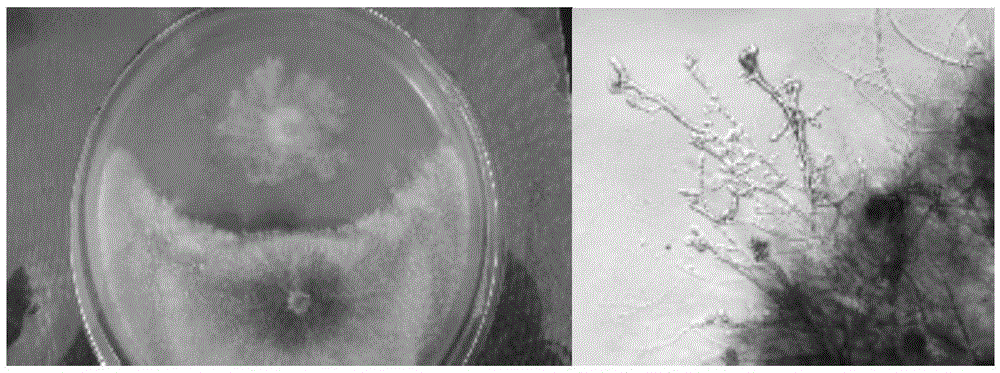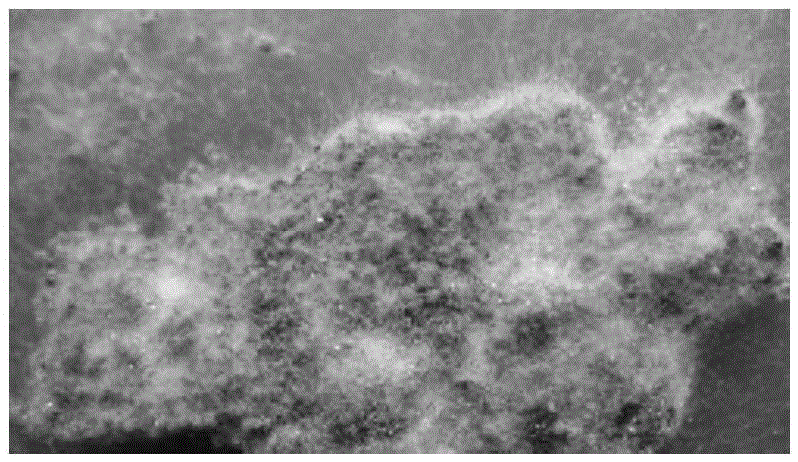Bacterial strain and microbial agent for preventing and curing apple tree rotten diseases and preparation method of microbial agent
A technology for apple tree rot disease and microbial inoculum, which is applied in the field of strains for preventing and controlling apple tree rot disease, can solve the problems of difficulty in wide application, difficulty in long-term colonization, complicated extraction process, etc., and achieves the effect of no toxic and side effects
- Summary
- Abstract
- Description
- Claims
- Application Information
AI Technical Summary
Problems solved by technology
Method used
Image
Examples
Embodiment 1
[0025] Example 1: Isolation, purification and identification of Chaetomium globosa for preventing and controlling apple tree rot
[0026] 1. Separation and purification
[0027] It is isolated from the bark of apple trees in the apple orchard of Baishui County, Shaanxi Province. Take 5g of dried apple tree bark, cut it into 1cm pieces, put it into a 1000ml triangular flask, add 10ml of special disinfectant, and shake it for 6-8min. Then add 600ml of sterile water, absorb 2ml of this suspension and spread it on the Martin medium plane, pour off the water, use tweezers to remove the warped skin and put it in a sterile petri dish, cut into small pieces and put them on the Martin medium plane, Incubate at 28°C.
[0028] After the clearly identifiable Chaetomium ascomycetes grew on the separation medium, a single ascomyce was picked under a dissecting microscope, and inoculated in water agar medium or PDA medium for culture and purification.
[0029] 2. Separation and identifica...
Embodiment 2
[0035] Embodiment 2: the control effect determination of the Chaetomium globosa of controlling apple tree rot
[0036] The control effect of 61239 Chaetomium globosa on apple tree rot was determined by plate confrontation culture method and mycelial growth rate method indoors. The confrontation culture results show that it has obvious inhibitory effect on the mycelium growth of apple tree rot fungus, see figure 1 . After confrontation culture for 8 days, a transparent antibacterial zone with a diameter of 13 mm was formed around the biocontrol bacteria. It can be seen under a microscope that the mycelium of the pathogenic bacteria around the antibacterial zone grows slowly, the top of the mycelia expands, and the cell wall is destroyed, and the protoplasts leak out. exhibits bacteriolysis, see figure 1 .
[0037] The 61239 Chaetomium globosa strain was selected for liquid fermentation, and the results showed that its fermentation filtrate had a significant inhibitory effect...
Embodiment 3
[0041] Embodiment 3: the preparation of the microbial inoculant of preventing and treating apple tree rot
[0042] (1) First-level seed cultivation: connect the slant spores of the chaetomium globosa strain 61239 according to claim 1 into the sterilized first-level seed culture medium, at a culture temperature of 32-36°C, with an air flow of 1:0.4-0.8 Cultivate for 45-60 hours under the condition of v / v / min and stirring; among them, the acquisition of primary seed medium: add 50g barley and 40g water to a 500ml Erlenmeyer flask, the pH is natural, stir evenly, and then sterilize at 121°C for 40min.
[0043] (2) Secondary seed cultivation: Inoculate 5-15% of the inoculum into the sterilized secondary seed culture medium, at a cultivation temperature of 32-36°C, with an aeration rate of 1: 0.8-1.2v / v / min and Cultivate under stirring conditions for 20-30 hours to obtain secondary seeds; among them, the acquisition of secondary seed medium: weigh 5Kg barley and 4Kg water, mix well...
PUM
 Login to View More
Login to View More Abstract
Description
Claims
Application Information
 Login to View More
Login to View More - R&D
- Intellectual Property
- Life Sciences
- Materials
- Tech Scout
- Unparalleled Data Quality
- Higher Quality Content
- 60% Fewer Hallucinations
Browse by: Latest US Patents, China's latest patents, Technical Efficacy Thesaurus, Application Domain, Technology Topic, Popular Technical Reports.
© 2025 PatSnap. All rights reserved.Legal|Privacy policy|Modern Slavery Act Transparency Statement|Sitemap|About US| Contact US: help@patsnap.com



